Definition of Network Culture, Techniques, Media, Stages and Examples

Definition of Tissue Culture
According to the term, tissue culture consists of two words, namely culture which means cultivation, and tissue which means a group of cells that have the same function and form. It can be concluded that this tissue culture is an attempt to cultivate cells that have or have a form and function similar to that of a plant, so that later it becomes a new plant that complete.
Tissue culture is done by isolating parts of certain plants, such as leaves, buds, and also others then grow a network into a closed container that is transparent to light and then with aseptic (sterile) principles, so that the plant can then regenerate into new plants that are complete.
The tissue taken for tissue culture should be meristem tissue, which is a young tissue that is still actively dividing, full plasma, thin walls, and vacuoles small. The use of the meristem tissue will also maximize the final yield of the culture.
This actual tissue culture process has been or has been going on for a long time. The first time, this tissue culture was carried out by Gottlieb Haberland using mesophyll plants found in monocot plants.
Types of Tissue Culture
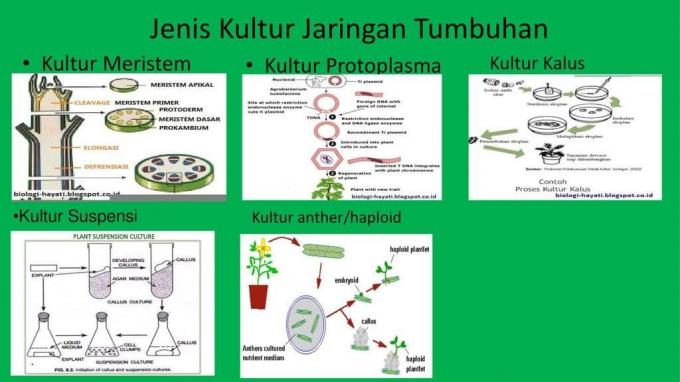
According to the selected tissue for culture, this tissue culture is divided into several types, including:
-
Pollen Culture
This type of culture is a tissue culture that uses pollen as the explant (the tissue selected for culture). -
Embryo Culture
Is a type of culture that utilizes parts of plants in the form of plant embryos. An example is the kopyor coconut embryo. -
Protoplast Culture
Is a type of culture that uses living tissue cells without walls, namely as eksplannya. -
Chloroplast Culture
Is a type of culture that uses a chloroplast (green cell) from a plant to make a complete new plant. -
Meristem Culture
Is a culture that uses plant parts in the form of young tissue that is actively dividing (meristems), namely as culture explants. -
Enter culture
Is a type of tissue culture that uses plant parts in the form of anthers as explants.
Network Culture Media
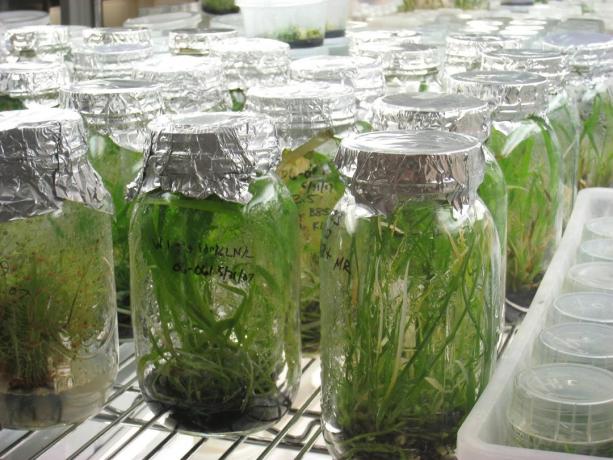
There are two kinds of media that can or can be selected for the tissue culture process, including:
-
Murashige and Skoog (MS) Basic Media
This medium is used in all types of plants, especially herbaceous. In this medium, high growth elements and minerals can be found. -
Basic Media B5 or Gamborg
This medium is used for cell suspension culture of soybean, alpha, and other legumes. -
White Basic Media
This medium is used for root culture. However, in this medium the mineral content and other substances needed by cultured plants are low. -
Vacint Went Media (VW)
This media is used specifically for orchid plants -
Nicsh Basic Media
This medium is used for pollen culture as well as cell culture -
Schenk and Hildebrant Dasar Basic Media
This medium is used for woody plants. -
Woody Plant Medium (WPM) Basic Media
This medium is also used for woody plants -
N6 Basic Media
This medium is used on cereal crops, especially rice, as well as other cereals.
Tissue Culture Techniques
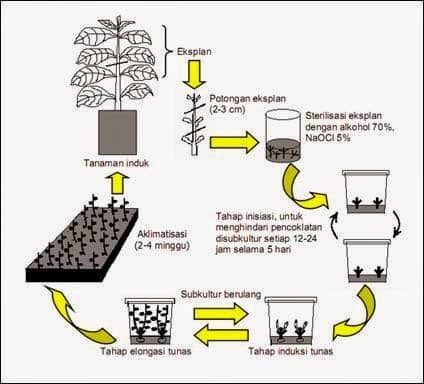
The technique used in the tissue culture process is vegetative plant growth. A slice of plant parts or cells or tissues taken is placed and maintained in 2 media, namely solid media and liquid media. Do not forget that this tissue culture requires aseptic (sterile) media.
By placing it on the media, the plant parts used will proliferate and form callus. If the callus is removed and placed in a suitable differentiation medium, it will form plantlets (small new plants).
This tissue culture technique actually uses the totipotency theory which was discovered by Schleiden and Schwan in 1838. Totipotency is the principle which states that any part of a plant is taken for growth culture, if placed in the appropriate media and environment, it will grow into a plant that perfect.
In tissue culture also developed with several methods including the following:
- Meristem culture, is the cultivation of tissue by using ex-plants from young tissue or meristems.
- Pollen culture/anther culture, this uses explants from pollen or stamens.
- Protoplast culture, this uses explants from protoplasts.
- Chloroplast culture, this uses chloroplasts for protoplast fusion purposes.
Somatic cross (protoplast number/protoplast fusion), crosses 2 kinds of protoplasts, after which they are cultivated until they become a small plant with new characteristics.
Network Culture Terms
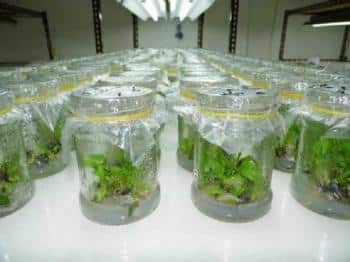
1. Explanation Selection
The tissue taken for culture should be young tissue that is still active in dividing, so that then it can or can help in the development of the next network which will then grow into a network new plant.
2. Media Selection
Good media and also suitable for use as tissue culture media are media that provide all kinds of media nutrients for tissue growth processes such as sources of carbohydrates, minerals, vitamins, and regulatory substances hormones. Therefore, we must add various kinds such as sources of carbohydrates, minerals, vitamins, and hormone regulating substances into the culture medium.
3. Environmental Selection
The condition or good environmental situation is to meet the aseptic requirements, namely as the principle of tissue culture. That is, all stages carried out in the culture process must be sterile. This has the aim of avoiding contamination with germs or bacteria. The sterilization of explants and media can or can be carried out in a laminar air flow. The storage area must also be considered, such as temperature, lighting, and also good air regulation.
Process and Stages of Tissue Culture

1. Selection and Preparation of Mother Plants as a Source of Explants
This is a very important thing. The selection of this plant starts from the type, species, and varieties that are clear. This plant must also be healthy and free from pests and diseases. Preparation for this selection can or can be done in laminar air flow or can can be done in a greenhouse, so that the plants you want to culture can grow good.
2. Culture Initiation
The purpose of cultural initiation here is to fulfill aseptic and accentic principles. Aseptic is free from microorganisms, while for accentic is free from unwanted microorganisms. The cultured explants can or can initiate new plant growth, so that we can or can choose the best part of the plant for the next culture process.
3. Sterilization
This sterilization is carried out in order to meet the requirements that all the work carried out in the tissue culture process must be free from the presence of contaminants. A sterile place that is in a laminar air flow, the tool you want to use must also be sterilized that using an ethanol solution, and the person or technician who performs the culture must also sterile.
4. Multiplication
This stage is carried out in doubling or also multiplying plant material and also maintaining this plant material so that it can or can be used at certain times. Propagation can or can be done by stimulating the growth of branch shoots as well as axillary and also stimulates from the formation of adventitious shoots, either directly or through callus stimulation first. first.
5. Shoot Elongation, Induction and Root Development
The shoots produced during multiplication were transferred from sterile in vitro media to the external environment in the shoot elongation process. After growing long enough, the shoot can then be rooted. Elongation of shoots or rooting can or can be done all at once or also in stages one by one. The success of this stage is determined by the quality produced previously processed.
6. Acclimatization
This acclimatization is the process of conditioning plantlets or micro shoots (if rooting is done ex-vitro) in a new environment. The new environment referred to here is a non-aseptic environment, which is like the bottle with the media soil or ferns, so that these plantlets can or can continue to survive it becomes a plant that is ready for bred.
This acclimatization is a very important and critical procedure in the whole tissue culture process. The success of this tissue culture is declared successful if the plantlets can or can be acclimatized to the external environment with a high success rate.
Cultural Benefits
- Can create new plants that are free from contaminants in the form of diseases or viruses or bacteria.
- Can preserve the plant with the same properties, namely the parent.
- Can produce new plants in a short time.
- Its implementation also does not depend on the season.
- Can create new varieties based on genetic engineering.
Impact of Tissue Culture
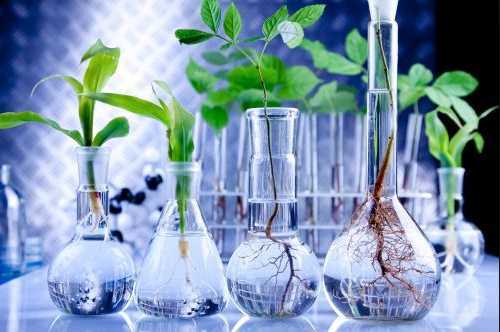
Below is the impact of tissue culture, namely the advantages and disadvantages of tissue culture, including:
Advantages of Tissue Culture
- The resulting seeds vary
- Procurement of seeds does not depend on the season
- Can or can produce that many seeds in a short time
- Cheaper and easier transportation costs
- The resulting seeds are protected from disease
- The seeds obtained have the same properties as the parent
- Plant secondary metabolites can or can be obtained immediately without waiting for the plant to mature
Disadvantages of Tissue Culture
- Requires an acclimatization process, due to the adjustment of the plant's habitat
- Requires relatively expensive initial costs
- Only that person with special skills can do
- In animal cell culture, the culture results cannot or can produce new individuals other than embryo culture
- Cannot or can change the nature of the resulting plant
Examples of Tissue Culture Plants
- orchid
- banana
- Palm oil
- ornamental plant sprouts
- sugarcane and chrysanthemum
Thus an explanation of the Definition of Network Culture, Techniques, Media, Stages and Examples, hopefully what is described can be useful for you. thank you
See AlsoUnderstanding Systems, Elements, Elements, Types, and According to Experts
See AlsoDefinition of Bibliography, Method, Purpose, Elements, Types, and Examples
See AlsoDefinition of Genetic Engineering
